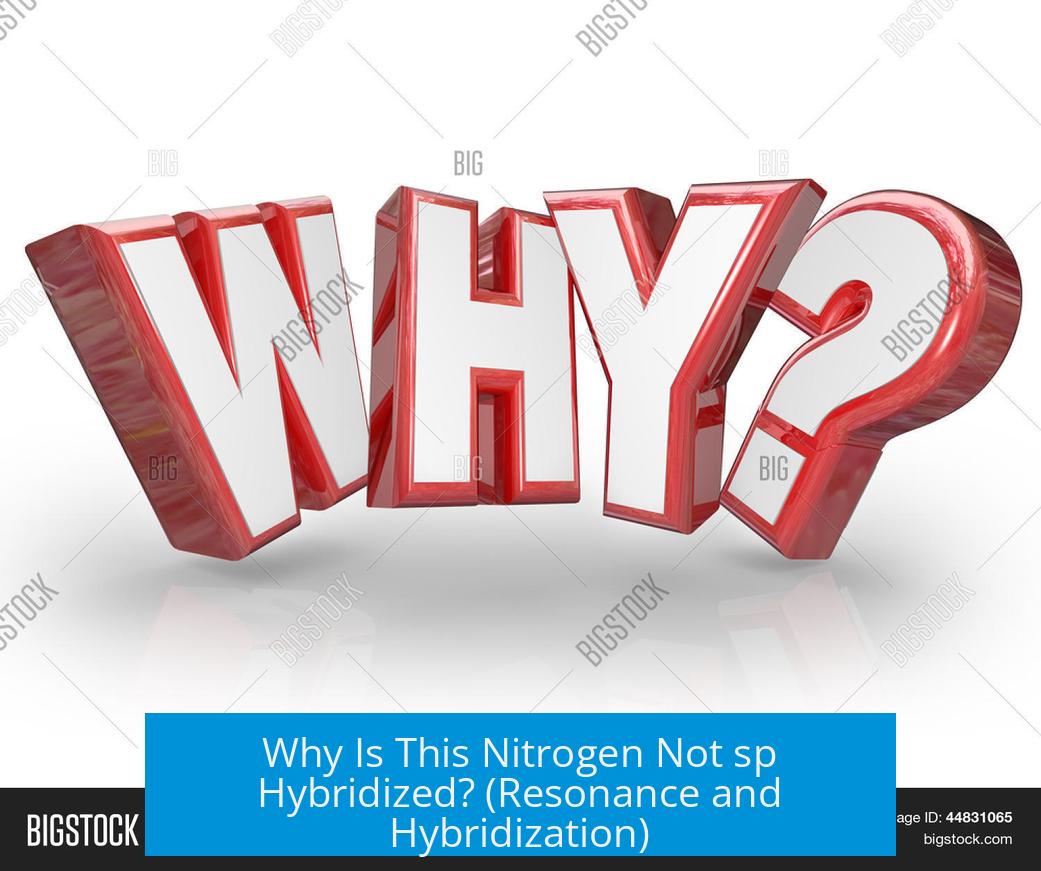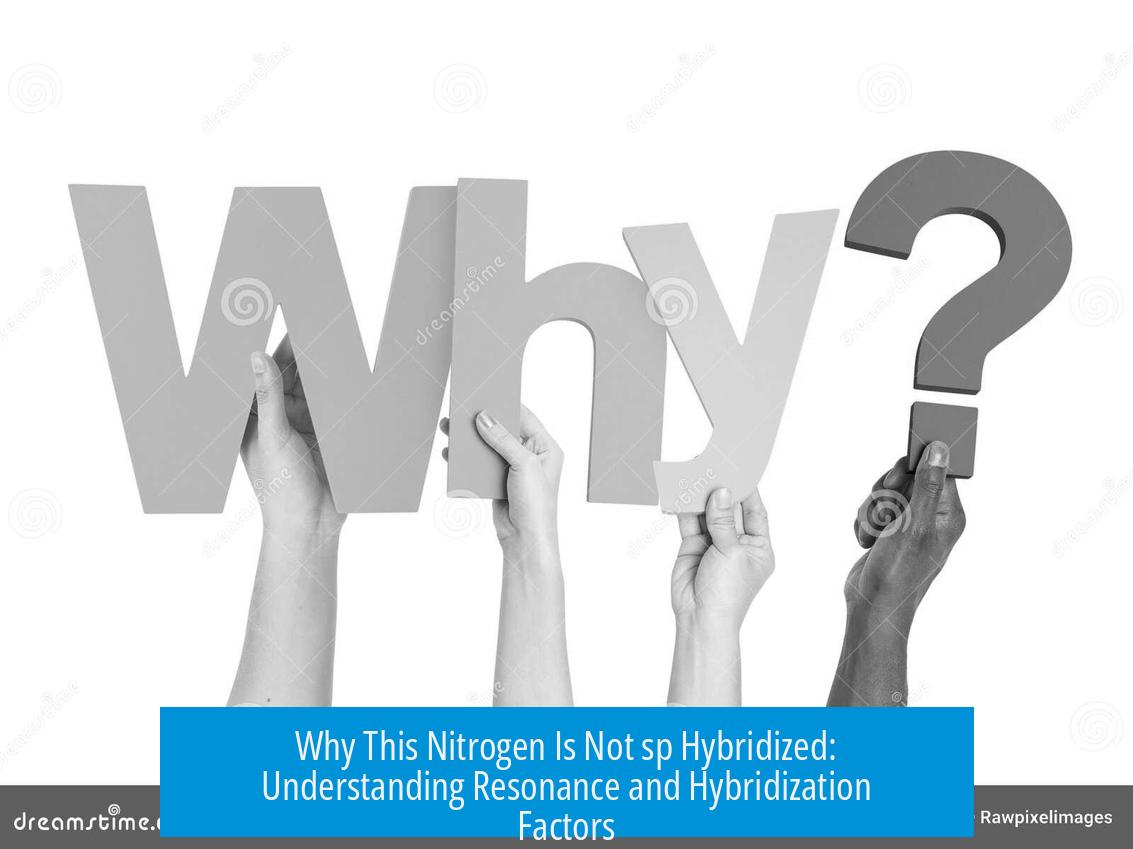Why Is This Nitrogen Not sp Hybridized? (Resonance and Hybridization)

The nitrogen atom is not sp hybridized because its lone pair electrons occupy an sp2 hybrid orbital oriented in the plane of the ring, perpendicular to the aromatic system’s p orbitals, thus preventing resonance. The molecular geometry, characterized by approximately 120° bond angles in the aromatic ring, dictates sp2 rather than sp hybridization to maintain proper orbital overlap and aromaticity.
Lone Pair Orientation Blocks Resonance
The nitrogen’s lone pair lies in the plane of the carbon-hydrogen bonds on the aromatic ring. This positioning places the lone pair at roughly 90° to the pi system’s p orbitals.
Because atomic p orbitals must overlap with parallel orientation for effective resonance, this orthogonal arrangement means the lone pair cannot interact with the aromatic pi electrons.
This geometric restriction precludes the lone pair from contributing to resonance.
Geometry Drives Hybridization
Hybridization emerges from the molecular geometry rather than defining it.
Here, nitrogen is part of a rigid aromatic ring structure which enforces around 120° bond angles, consistent with sp2 hybridization.
On the other hand, sp hybridization requires a linear environment with bond angles near 180°, incompatible with this ring’s geometry.
Orbital Composition and Role in Quinoline
In quinoline, nitrogen adopts sp2 hybridization. This arrangement yields one unhybridized p orbital perpendicular to the ring plane.
This p orbital overlaps sideways with neighboring carbon p orbitals, sustaining the aromatic pi-electron cloud.
The nitrogen’s lone pair resides in an sp2 hybrid orbital, distinct from the unhybridized p orbital, thereby excluded from the pi-electron system.
If nitrogen were sp hybridized, it would possess two unhybridized p orbitals at right angles to one another. This configuration disrupts overlap with the ring’s pi system, threatening aromatic stability.
| Hybridization | Bond Angle | Lone Pair Orbital | Participation in Pi System |
|---|---|---|---|
| sp | ~180° | Unhybridized p orbitals (2 perpendicular) | Limited or none |
| sp2 | ~120° | Lone pair in sp2 orbital; one p orbital overlaps in pi system | P orbital involved; lone pair excluded |
Contrast with Other Nitrogens: N3 Case
A nitrogen such as N3 in quinoline differs from the nitrogen under discussion.
N3’s lone pair occupies a pure p orbital, enabling conjugation with adjacent groups like carbonyl moieties.
This lone pair participates actively in resonance, contributing to molecular stability and electronic distribution.
Still, this nitrogen is also sp2 hybridized, reflecting planar geometry and electron delocalization capacity.
Planarity and Aromaticity Reinforce sp2 Hybridization
Planar aromatic compounds require overlapping p orbitals arranged in a continuous cycle.
Nitrogen atoms embedded in such systems typically adopt sp2 hybridization to maintain planarity.
This hybridization places one p orbital perpendicular to the molecule’s plane, aligning with neighboring p orbitals for optimal overlap.
The lone pair’s position in an sp2 orbital aligns with maintaining aromatic properties rather than participating directly in resonance.
Summary of Reasons Nitrogen Is Not sp Hybridized
- The nitrogen lone pair is in an sp2 orbital oriented perpendicular (90°) to the pi system’s p orbitals, disallowing resonance.
- Ring geometry enforces ~120° bond angles, consistent with sp2, not sp hybridization.
- One p orbital on nitrogen overlaps with adjacent carbon p orbitals, preserving aromatic continuity.
- Adopting sp hybridization would disrupt orbital alignment, destabilizing aromaticity.
- Planar aromatic systems mandate sp2 hybridization to maintain electron delocalization.
Key Takeaways
- Nitrogen’s lone pair orientation dictates its exclusion from resonance in this aromatic ring.
- Bond angles fix hybridization at sp2 rather than sp in rigid aromatic rings.
- Proper p orbital overlap sustains aromaticity and prevents sp hybridization.
- Different nitrogens in quinoline adopt similar hybridization but have distinct resonance roles based on lone pair positioning.
- Planarity in aromatic compounds ensures sp2 hybridization of nitrogen atoms.





Leave a Comment